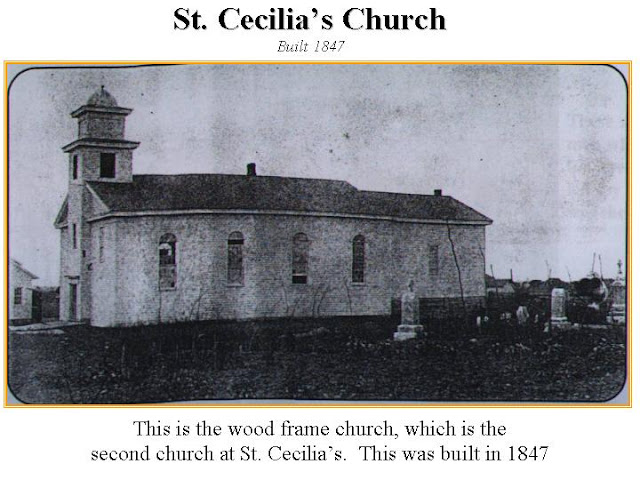Featured
- Get link
- X
- Other Apps
Beyond Sacramental Records: Find Family in Church Artifacts
The other day I saw a photograph of a plaque which hangs at St. Cecilia Catholic Church in Sheldon, New York. It is a list of most of the founding families of that parish, who celebrated their first Mass with missionary priests in the late 1830s. Later, some of the ancestral families in my paternal grandmother's Baker line would attend St. Cecilia Church. Though they are not on the plaque, they are well-represented in the church's sacramental records.
 |
| St. Cecilia Church "First Families" plaque. (Photo: Barb Durfee) |
This plaque and a Facebook post about the dome being placed on the new St. Mark Catholic Church under construction in Denton, Texas, got me thinking about my family's contributions to churches, and how they might be found in genealogical records or on-site artifacts. I used to attend St. Mark Church but moved out of the area. I contributed to the building fund in the past, and my donation is likely recorded somewhere there. Where else am I recorded? Where are our ancestors recorded?
My mother, Anna Margaret Kozlina Gilbride, was also a donor. She supported the renovation of St. Mary Magdalene Church in Willowick, Ohio, in the 1980s. Mom related the story of how after we moved to Willowick, and she and my
dad divorced, she desperately wanted all of us to attend Catholic
school. But she could not afford the tuition for the three of us who
were then school-aged. She told me she went to the priest at St. Mary
Magdalene, and promised that she would give back to the church when she
could if he would allow us to attend there. I don't know how long that arrangement lasted, but later in life she made good
on that promise by donating to the renovation. She was proud to do
so. Her participation is now memorialized on one of several plaques which hang in the vestibule of the church which name donors to that cause.
 |
| Plaques naming donors to St. Mary Magdalene's renovation hang in the church vestibule. |
 |
| Mom's name is the fourth entry in the middle column. |
Another fundraiser that St. Mary Magdalene held was the sale of memorial bricks for their courtyard. After my mother passed away in 2010, my brothers and I purchased a memorial brick for her, and one for our sister, Sharon, who passed away in 1994. The two bricks are side by side in the church courtyard just to the left of the back entryway.
The bricks were a fitting tribute and memorial to the connection our family had to the church and school. Mom was a long-time parishioner at Saint Mary Magdalene. My siblings and I all attended St. Mary Magdalene School through eighth grade; Sharon was the last of us to be a student there, graduating in 1981. Both Sharon and Mom were buried out of the church. Like the donor plaque, the bricks remain there as physical records of their connection.
Did your ancestors donate to a church? Perhaps their names are inscribed on a plaque or brick at the church. Were they church founding members? They might be listed in church histories published in anniversary years. Did they contribute funds for an organ, piano, or stained glass windows, and have their names inscribed on the item? Are they included in parish directories? Mine is included in St. Mark parish directories from the 2000s. Family could also be listed as founding members, trustees, or elders of their church in county histories. These are just a few examples of church documents and artifacts where family information might be found.
How can you find these items?
- Reach out to family churches to see what records or artifacts they might hold for your ancestors. Ask about donor lists, on-site memorials, founding family documents, parish directories and histories, or bulletins.
- Look around the church building and grounds the next time you visit, paying careful attention to items like registers, plaques, or photos, which might name family members.
The evidence of your family's faith and contributions to their church might be waiting to be discovered.
Until next time...
© Nancy Gilbride Casey, 2024. All rights reserved.
This post was chosen as a "Friday Family History Find" on Empty Leaves on Family Trees blog, by blogger Linda Stufflebean. Thanks, Linda!
IMAGES
All photos by the author, unless noted below:
Barb Durfee, undated image of St. Cecilia Church taken from photograph at church; image, RootsWeb (https://freepages.rootsweb.com/~evansandobertein/genealogy/stcecilias/hhhhhhhh/1847chruch.htm : 17 December 2023). Used with permission.
Barb Durfee, photographer, St. Cecilia founding families plaque, undated; image, RootsWeb (https://freepages.rootsweb.com/~evansandobertein/genealogy/stcecilias/churchphotos/1stchristians.htm : 17 December 2023). Used with permission.




Comments
Post a Comment